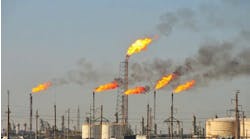Even though it's crucial for life and increasingly precious, clean water is sadly almost completely taken for granted. For now.
In much of North America and Europe, most water/wastewater applications have been so reliable and so inexpensive for so long that they've mostly faded into the background. One perverse result is the ridiculous, illogical and wasteful devotion to bottled water. However, this illusory paradise is itself beginning to wane as populations grow worldwide, as water/wastewater infrastructures age and break, and as fresh water sources are used up.
As a result, some municipalities and even a few legislators are waking up to the unavoidable necessity of increasing water rates and spending on vital efficiency upgrades and expansions to their water/wastewater systems.
To help water/wastewater engineers and managers understand their new context and give them the new efficiency tools they need, Rockwell Automation hosted presentations by three experts at its latest Water/Wastewater Forum on the second day of Automation Fair 2010 at the Orange County Convention Center in Orlando.
"In the U.S., a water pipe breaks every two minutes." Tom Decker, consultant to the water/wastewater industry decried the aging water infrastructure, which in some U.S. cities is 100 years old.
The first presenter, consultant Tom Decker, reported that economic and construction activity in the water/wastewater field was flat in 2009 due to the recent housing bubble and recession. However, he added that the industry has been aided by $4 billion in stimulus funds from the American Recovery and Reinvestment Act (ARRA), which helped fund 1,860 mostly small or continuing clean water/wastewater improvement projects.Decker reported that water/wastewater is a $500 billion industry worldwide, but far more investment will be needed as the globe's population reaches 9-10 billion by 2050 with 70% of it living in cities. Also, he added that 40% of the world's population will be in extreme water distress by 2050.
Besides adding capacity, he explained that upgrading existing water/wastewater infrastructure is needed to stop the 7 billion gallons of water lost each day due to leaky pipes. "In the U.S., a water pipe breaks every two minutes, and the average age of the pipes in some U.S. cities is 100 years old," he said.
Fortunately, huge resource and energy savings can be achieved by making repairs, adding more efficient pumps and motors, and by implementing better information monitoring, processing and analysis tools.
For example, the second speaker, Dave Ubert, reported that Boca Raton, Florida, is in the process of migrating the supervisory control and data acquisition (SCADA) system and process controls at its Glades Road water treatment plant from its longtime DCS system and Bristol Babcock 3330 and 3305 controllers to Rockwell Automation's PlantPAx architecture. Ubert is project manager, senior designer and instrumentation specialist for Camp, Dresser and McKee (CDM), and offered some advice on how other water/wastewater applications can make the same trip.
"This process is like running a marathon, and so you have to set a well-thought-out goal, start right and follow a consistent pace," said Ubert. "First, you have to define the limits of your plant and what it needs. In Boca Raton's case, the old DCS and PLCs were obsolete, and so they were getting costly to fix."
As a result, Ubert says he and Boca Raton's staff developed an inexpensive preliminary design report (PDR) to help define and justify the migration project's requirements and overall importance to its community. "The PDR also broke out all the parts of the project, which would allow us to remove items that might not be approved, but also let us focus in on the needs of individual applications and operators. We asked the operators about all the needs they saw at the plant, and that really helped the PDR and the project."
The PDR also revealed that Glades Roads has numerous different distributed controls technologies, a potentially useful but problematic fiber-optic network, and a unique, DCS-based telemetry system that had to be retained in the new system and kept running during the migration. This telemetry equipment starts and stops water delivery to the plant's reverse osmosis plant, membrane units and remote locations. "Likewise, another big challenge was doing our controls migration at the same time that the plant was replacing many of its well pumps, and so the new pumps had to be accounted for in our plan, too," said Ubert.
Consequently, because Glades Roads had 17 existing DCS panels and other equipment that the new controls needed to link to, Ubert explains that he and CDM decided to use PlantPAx because it can establish those ties, as well as work with the fiber-optic and telemetry-based equipment. "We even shut the panels down one at a time to make sure what would happen, and this also helped us design the new open-architecture system, make it easy to expand, and set up the construction sequence," explained Ubert. "The main benefit for Boca Raton of PlantPAx is that it will give the water treatment much better maintainability."
Similarly, the third speaker, Ian Took, reported that once data is collected from a water/wastewater application, then the next question is how to store and convey that operational intelligence (OI) to users to make better decisions. Took is business solutions practice manager for Grantek Systems, which uses Rockwell Automation's FactoryTalk software to power its OI solutions, and is one of a few of Rockwell Automation's Enterprise Solutions Partners.
Took added that water/wastewater treatment facilities in the York Region and Niagara Region of Ontario, Canada, are using Rockwell Automation's FactoryTalk VantagePoint to impose a logical data model over many disparate data sources in their existing equipment and systems. "For instance, this enabled our users to more easily and quickly check the last time a pump was maintained, find its efficiency rating, or see what flow it's running—and now they can do it without going to several different sources or set up a bunch of programming." In fact, VantagePoint's Core OI function has reporting, query and analysis, customizable dashboard and other information delivery options, while its Extended OI level allows further analysis of performance management, enterprise search, visualization and mapping, and mobile applications.
As a result, the York Region's water/wastewater application estimates it saved more than 720 hours per year on generating compliance and ad hoc reports, saved a man-year of time on billing generation, gave its staff access to more and better data via web browsers, and removed bad data from its applications.



